What are smart motorways and how do they work?
Contents |
[edit] Introduction
Smart motorway technology is deployed to actively manage traffic flows and optimise the motorway network. Stuart Wilson, technical director at Sweco, explains the types of smart motorway technology and how they are used to achieve operational outcomes.
[edit] Smart motorways - a quick overview
A smart motorway is defined as a concept that uses technology and procedures to monitor and respond to fluctuating traffic conditions on our motorways. Smart motorways which are being designed and installed have evolved from several years of feedback, lessons learnt and improvements since their first deployment on the M42 motorway in 2006.
[edit] Why do we need smart motorways?
According to several studies, the financial impacts of congestion on the strategic road network is estimated to cost £2 billion per year - an amount likely to increase further due to the predicted traffic growth up to 2035. The key aims of smart motorways is to reduce congestion and improve journey times by better managing the traffic using roadside technology infrastructure, associated control centres, systems and operational regimes.
Smart motorways support the economy by providing much needed capacity on the busiest motorways, while maintaining safety for motorists and those who work on the roads.
Other benefits of differing types of smart motorway have included reductions in accidents and reduced impacts on the environment associated with emissions from stationary or slow-moving vehicles.
[edit] How does a smart motorway work?
Smart motorways function by adopting various operating regimes to meet scheme operational requirements including:
[edit] Controlled motorway
Variable mandatory speed limits are used on all types of smart motorways. A mandatory speed restriction refers to the use of a red ring speed restriction which is legally enforceable.
Traffic conditions are monitored using vehicle detection equipment installed in or adjacent to the motorway at strategic locations. The vehicle detection equipment is linked to a Motorway Incident Detection and Automatic Signalling (MIDAS) system which analyses the data and recognises two differing traffic conditions – queueing traffic or congestion.
Queue protection and congestion monitoring algorithms within the MIDAS system recognise differing traffic conditions and automatically set appropriate signs and mandatory speed restrictions on signals to actively manage traffic conditions. Safety specific intervention is provided by the queue protection algorithm which protects the back of queueing traffic, and congestion is managed by introducing reduced speed limits to increase traffic throughput.
In addition to the MIDAS system, additional technology is being added to smart motorways schemes for the purpose of detecting stationary vehicles.
[edit] Hard Shoulder Running (HSR)
HSR uses the same systems, algorithms and mandatory signal settings as controlled motorways in addition to actively managing the hard shoulder. HSR systems dynamically open and close the hard shoulder at peak periods to reduce congestion and increase capacity. HSR allows differing levels of automatic and manual intervention dependent on the traffic conditions.
[edit] All Lane Running (ALR)
Following lessons learnt, feedback, driver surveys and simulations, the smart motorways ALR concept was introduced.
ALR schemes permanently convert the hard shoulder into an additional running lane, while operating with all of the features, systems and signalling associated with controlled motorway schemes.
[edit] What types of technology are used, and what do they do?
[edit] Message signs and signals
Message signs are used to provide information to motorists in relation to the road conditions ahead.
Where they are not co-located with individual signals, some types of message signs can also display variable mandatory speed limits.
Signals display mandatory variable speed limits above carriageway lanes and can also be used to open or close any of the lanes, including the hard shoulder (for HSR schemes).
[edit] Closed circuit television (CCTV) cameras
Comprehensive CCTV coverage is provided within smart motorways schemes to supports operation of the scheme. Different types of cameras include:
- Pan, tilt zoom (PTZ) CCTV cameras – provide comprehensive coverage of the scheme to allow operators within the control centre to monitor the extent of a scheme.
- Hard shoulder monitoring (HSM) cameras – HSR schemes require 100% coverage of the hard shoulder which allows an operator to ensure it is completely clear of breakdowns or debris prior to dynamically opening the hard shoulder.
[edit] MIDAS vehicle detection
In order to understand traffic conditions (such as speed and flow) the MIDAS system gathers traffic data from vehicle detector sites which are positioned at strategic points along the motorway network.
There are two main types of detectors deployed within smart motorway schemes which support the MIDAS system as follows:
- Inductive loops – the traditional form of vehicle detection on motorways. They are cut into the road surface and measure the change in inductance as a vehicle travels across them to determine vehicle speed and traffic flow.
- Radar vehicle detection – used increasingly to gather traffic parameters. They are positioned on poles adjacent to the carriageway, reducing construction requirements, removing the requirement for complex traffic management during loop cutting and also reducing ongoing maintenance requirements.
[edit] Stopped vehicle detection
In addition to the above MIDAS detectors, stopped vehicle detector (SVD) radar devices are also being installed on all smart motorways, including retrofitting to previously completed schemes.
This radar operates by monitoring the entire carriageway and identifying stopped vehicles to the control centre and alerting the operators. This allows for quicker identification of stopped vehicle incidents and supports the process of implementing associated interventions, such as lane closures and speed restrictions.
[edit] Variable mandatory speed limit / Red X enforcement
To ensure motorist compliance and to realise scheme operational benefits, Highways Agency Digital Enforcement Camera System (HADECS) equipment is installed within smart motorways. These cameras can monitor all lanes of traffic simultaneously and adjust the speed thresholds at which they capture offences to align with the varying speed restrictions.
The system was also upgraded to provide enforcement of red ‘x’s by identifying and recording vehicles that illegally pass under a red x displayed on the associated gantry.
--The Institution of Civil Engineers
This article originally appeared on The Civil Engineer portion of the ICE website. It was written by Stuart Wilson, technical director, Intelligent Transport Systems, Sweco, and published on 4 January 2022.
[edit] Related articles on Designing Buildings
Featured articles and news
Latest Build UK Building Safety Regime explainer published
Key elements in one short, now updated document.
UKGBC launch the UK Climate Resilience Roadmap
First guidance of its kind on direct climate impacts for the built environment and how it can adapt.
CLC Health, Safety and Wellbeing Strategy 2025
Launched by the Minister for Industry to look at fatalities on site, improving mental health and other issues.
One of the most impressive Victorian architects. Book review.
Common Assessment Standard now with building safety
New CAS update now includes mandatory building safety questions.
RTPI leader to become new CIOB Chief Executive Officer
Dr Victoria Hills MRTPI, FICE to take over after Caroline Gumble’s departure.
Social and affordable housing, a long term plan for delivery
The “Delivering a Decade of Renewal for Social and Affordable Housing” strategy sets out future path.
A change to adoptive architecture
Effects of global weather warming on architectural detailing, material choice and human interaction.
The proposed publicly owned and backed subsidiary of Homes England, to facilitate new homes.
How big is the problem and what can we do to mitigate the effects?
Overheating guidance and tools for building designers
A number of cool guides to help with the heat.
The UK's Modern Industrial Strategy: A 10 year plan
Previous consultation criticism, current key elements and general support with some persisting reservations.
Building Safety Regulator reforms
New roles, new staff and a new fast track service pave the way for a single construction regulator.
Architectural Technologist CPDs and Communications
CIAT CPD… and how you can do it!
Cooling centres and cool spaces
Managing extreme heat in cities by directing the public to places for heat stress relief and water sources.
Winter gardens: A brief history and warm variations
Extending the season with glass in different forms and terms.
Restoring Great Yarmouth's Winter Gardens
Transforming one of the least sustainable constructions imaginable.
























